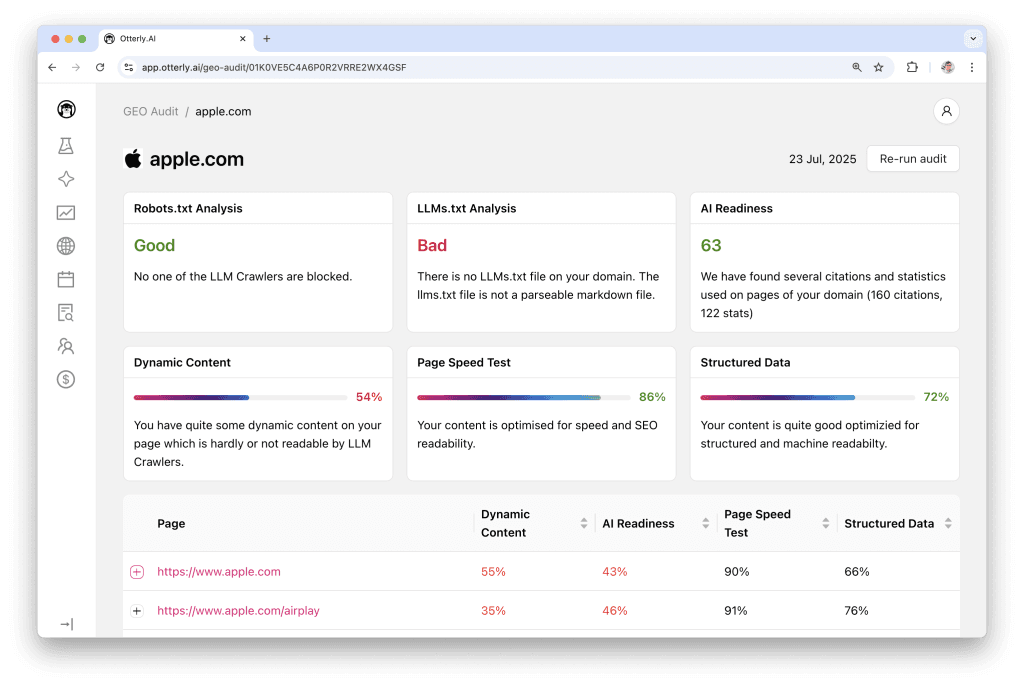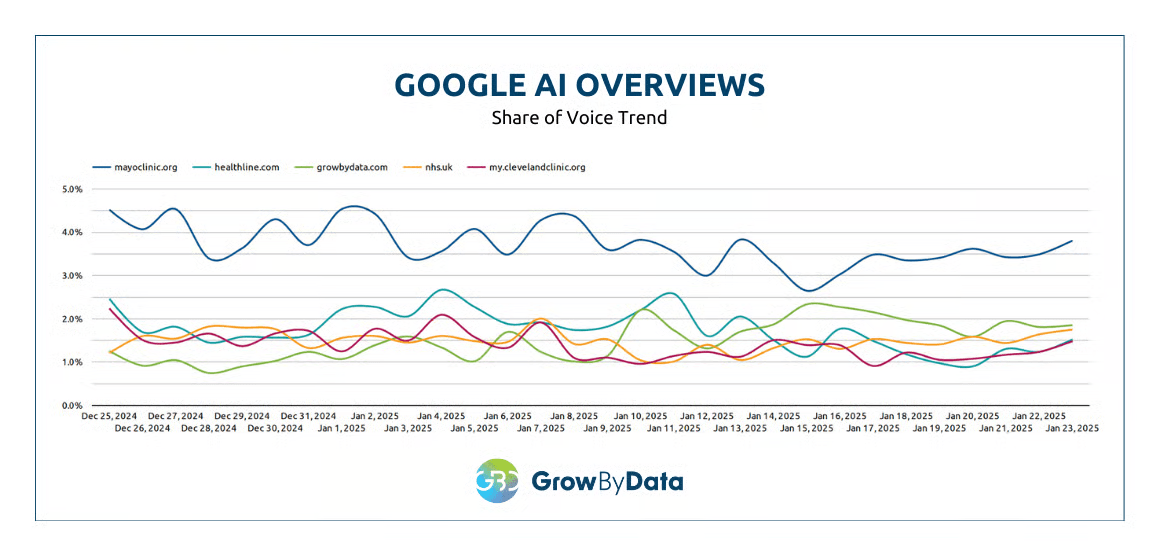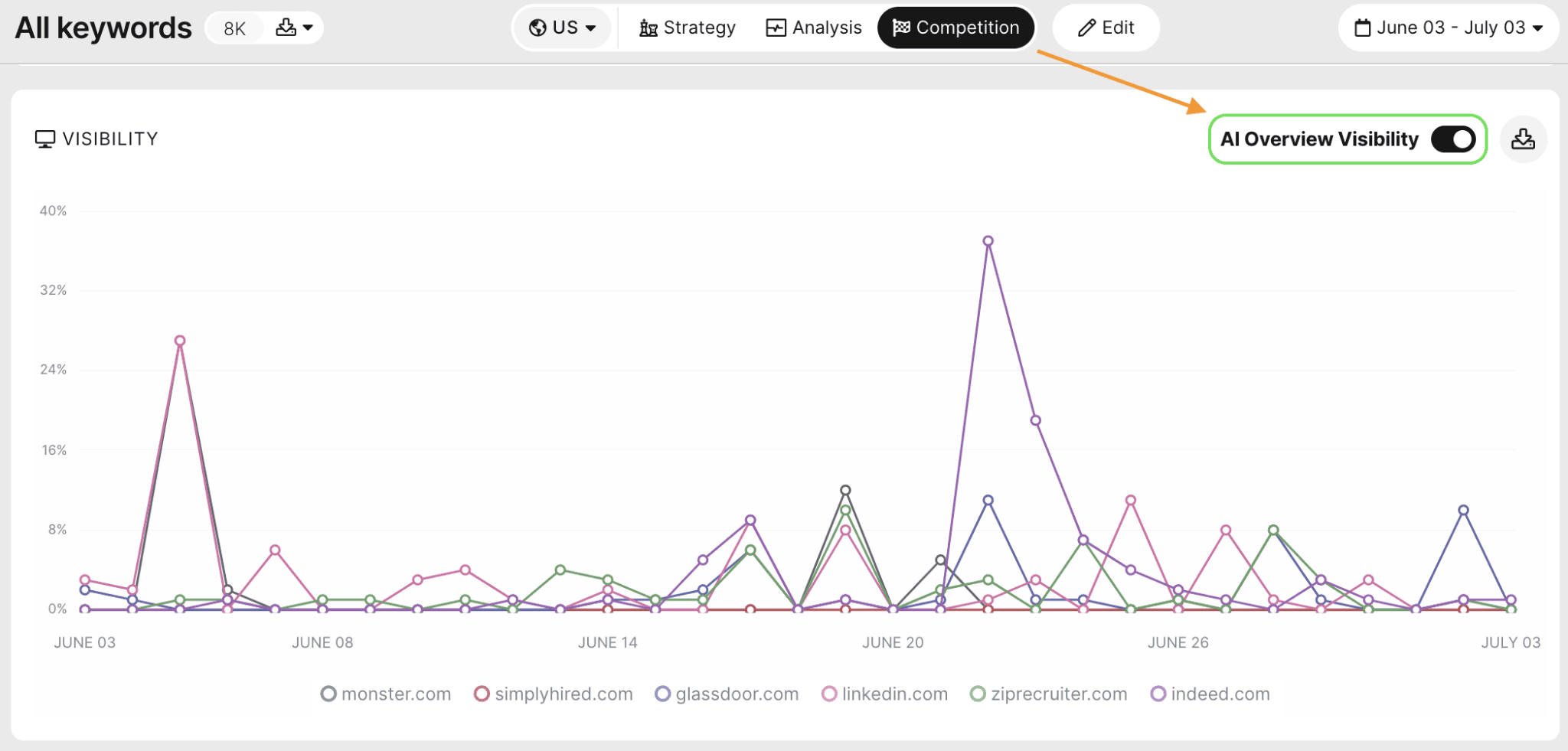The new AI Mode of search in Google offers more detailed search results, including source citations rather than ten blue links. It is an end-to-end AI search driven by Google’s Gemini model that integrates information across queries. Google has over 14 billion searches per day, and the introduction of AI in the company would only result in an even greater number of questions directed through this interface.
As searchers stop clicking on search results and start reading results generated by AI, trend tracking has now become as relevant as regular ranking results. Past AI Overviews (the less complex Google snippet AI) had demonstrated that adding an AI answer reduced click-through rate by 34% or more. Because the traffic related to AI Mode cannot be independently reported with standard tools, like Google Search Console.
There are several AI Mode (and other AI search engines) trackers to use on Google to trace your brand in 2025. In this article, we walk you through the best AI mode trackers to keep an eye on your brand and review its performance relative to the competition.

What’s AI Mode?
Google AI Mode is a new conversational search mode that functions like a chat agent rather than a link list. It divides a complex query into multiple sub-queries, runs the queries in parallel, and composes an answer with references. AI Mode will always reference sources (similar to Google's AI Overviews), yet doesn’t display standard organic listings on the results page. In AI Mode, you see the AI answer and the ads instead of ten blue links to web pages.
And this is unlike AI Overviews (a SERP feature by Google) and other generative tools. When using AI Overviews as a traditional search, the snippet at the top is AI content followed by links. The interface of AI Mode is fully AI. The AI Mode, in turn, is not as an independent chatbot like ChatGPT or Perplexity but rather as a search engine with its own search features (e.g., Deep searches, Live in-the-moment searches with images/audio, Shopping searches, and user context).

SEOs can’t ignore AI Mode due to a shift in user attention. People who used it before and had to go through links before getting the answer can now access answers in the AI Mode. AI answers may decrease the number of clicks in Google searches.
Using AI Mode, unless your site appears in the response, you will receive virtually no new traffic on such a query because no link would show. The general meaning here is that, just because you were ranked first on Google does not necessarily mean you would be displayed when that query would switched on AI Mode. Now SEO gurus will have to switch gears and abide by referrals and mention share in AI responses rather than conventional SERP.
The key SEO goal has to change from "first place" to "first source". Rather than the numerical ranking on a list, visibility shifts to whether a brand has been referenced or cited as a source of content in an AI-generated response.
A new form of visibility is the increasing capability to build brand presence and implied authority in the search result itself, without necessarily getting the searcher to click on the link. The goal then becomes not how to win the click but how to be the trusted authority that the AI trusts enough to summarize, which requires a new model of measurement and content strategy.
Another problem, though, is that Google has confirmed that GSC is now counting AI Mode data but not segmenting it together with blue links and other search features. This form of measurement obfuscation makes it all but impossible for a marketer to distinguish between a successful brand mention and an unsuccessful click-based search, thus requiring new, different tracking tools to measure this new type of brand value.
Key Features to Look for in AI Mode Tracking Tools
While traditional tracking tools are designed for monitoring static metrics such as keyword rankings and click-through rates, the new generation of AI tracking tools was designed for a different purpose: to provide strategic insight into your brand's presence.
AI Key Metric—Performance Tracking
The core ability of any AI Mode checking tool is to track brand mentions and content citations across AI search results. This does not mean monitoring whether a site is linked, but to measure linked and unlinked mentions of a brand. A robust tool should be able to provide some sort of metrics like popularity (number of mentions), average rank of a citation in an AI-generated answer, and volume of citations over time.
State-Of-The-Art Competitor Intelligence
The best AI Mode analysis tools identify "missed opportunities" (specific prompts or questions where a competitor is mentioned but your brand is not). By watching who is winning these citations and how well they do it, a brand can identify key content gaps and then adjust its messaging to capture that share of voice.
Vertical's Deep Content & Sentiment Analysis
The best AI Mode tracking tools can summarize and synthesize information if AI misdirects a brand's message. A useful tracking tool, therefore, includes sentiment analysis to help marketers determine if brand mentions are positive, negative, or neutral.
Cross-Platform Coverage
User journey is no longer limited to a search engine. The best AI Mode tracking tool would need to monitor visibility across various platforms, such as Google AI Mode and AI Overviews, as well as on non-Google-specific platforms such as ChatGPT, Perplexity, Gemini, and Claude.
Reporting and Historical Visibility
To justify value and provide data insights for long-term strategy, every best AI Mode checking tool needs effective reporting features. This includes providing historical visibility graphs to visualize trends and side-by-side competitor analysis reports you can export and share with clients and stakeholders.
Additionally, to ensure a smooth transition, the new tools should also integrate with existing SEO platforms. Through the use of AI Mode analysis tools that can complement and integrate with traditional data sources like GSC and GA4, you gain a comprehensive overview of its performance.
The 2025 AI Mode Tracking Tools Deep Dive
The AI Mode analysis tool market today is evolving from limited enterprise tools at a lower end of the price range to all unique approaches at a higher end. Not a single tool is the best. Although the best tool available meets a particular business's needs and budget. The following table gives a brief overview of five of the major companies in this new arena.
SE Ranking

SE Ranking is a full-scale SEO platform known for blending traditional optimization tools with AI search tracking. Its AI Search Toolkit supports AI Mode, ChatGPT, AI Overviews, Perplexity, and Gemini. AI Mode Tracker offers precise monitoring of how your brand or website appears in Google’s AI Mode responses, helping you evaluate presence, position, and performance.
You’ll see which keywords and prompts trigger AI Mode answers that mention your brand or link to your site. The tool also lets you analyze your placement and compare visibility side-by-side with competitors. Daily updates, cached answer snapshots, and historical data measure and build strategies to improve AI visibility without relying on guesswork.
Pros & Cons
Pros:
- Dedicated AI Mode tracking with accurate mention and link analysis
- Tracking across multiple AI platforms, including ChatGPT, AIOs, Gemini, and Perplexity
- Competitor benchmarking to spot missed opportunities
- Cached AI responses for transparency and message control
- Daily updates with historical trend tracking
- Part of the bigger SE Ranking platform
Cons:
- No sentiment analysis functionality yet
- Comes with higher pricing plans or via an add-on
Pricing
SE Ranking’s AI Mode tracking features are part of its AI Search Toolkit, available in Pro Plan at $119/month and Business Plan at $259/month. A separate AI Search add-on is available starting at $89/month for extended tracking. All pricing plans and add-ons come with a 20% discount for annual subscriptions. A 14-day free trial is available.
seoClarity

seoClarity is an enterprise-level AI Mode tracker that provides an integrated set of features for enterprise-scale operations. Its AI Mode tracking is a mandatory add-on and provides granular visibility of AI. Highlights of this tool are query discovery, which finds relevant topics to trigger AI Mode, traffic/visibility impact analysis, and deep citation tracking for you to find mentions linked to and unlinked to your website. It is claimed to be the first enterprise solution for this type of tracking and offers features for competitor comparison and content performance analysis.
Pros & Cons
Pros:
- Enterprise-grade features
- Heavily integrated with the overall SEO Suite
- Supports thousands of queries
- Real-time feed
- Excellent analytics to correlate AI Mode mentions with traffic impact
Cons:
- High price point makes it inaccessible for small to mid-sized teams
- Has a steep learning curve
- Limited to Google only (no multi-LLM support beyond Google)
Pricing
Enterprise clients are charged between $2,500 and $4,500 per month, but it can reach as much as $10,000 per month depending on the number of domains and keywords being monitored. While we could not find any specific pros for the features of the tool in the research content, the high barrier to entry is one of the reasons for the market positioning of the tool.
Writesonic

Writesonic is an AI visibility and Generative Engine Optimization (GEO) platform that helps enterprise brands understand and improve how they appear across AI search systems like ChatGPT, Perplexity, Gemini, Claude and Google AI Mode. For the latter, it shows which prompts and queries trigger mentions of your brand, how your site is positioned in AI-generated summaries and where competitors are outranking you.
The Action Center goes beyond monitoring by providing step-by-step workflows to help you score third-party citations, optimize or create new content for AI discoverability and address technical blockers. You also get analytics that connect AI citations to actual traffic behavior.
Pros & Cons
Pros:
- Dedicated AI Mode tracking with detailed citation and mention data
- Actionable GEO workflows that turn AI insights into improvements
- Cross-platform visibility tracking across major LLMs
- Competitor benchmarking to understand share-of-voice
- Unified analytics combining AI prompts and traffic behavior
- Supports SEO and content optimization in one workspace
Cons:
- Advanced capabilities may exceed the needs of small teams
- Some workflow automation features are limited to higher tiers
Pricing
Writesonic’s AI Mode tracking is included in its Professional Plan at $199/month (billed annually) or $249/month monthly. The Advanced Plan adds deeper AI Mode analytics, prompt-level insights, and enterprise dashboards for $399/month (annual) or $499/month monthly. Custom Enterprise pricing available.
Otterly AI

Otterly AI is a dedicated AI Mode tracker for automated brand monitoring across a wide range of AI search platforms such as Google AI Overviews, ChatGPT, and Perplexity. Its main value proposition saves time by automating a process that would otherwise involve manual, irregular, and unscalable checks.
At a glance, these features include an AI keyword research tool to find conversational questions, brand and website citation monitoring, and a Generative Engine Optimization (GEO) audit tool that reviews over 25 on-page factors to help sites increase their odds of getting cited. It also offers advanced sentiment analysis that ensures brands know they are accurately being represented in AI-generated responses.
Otterly AI is an automation and holistic view tool known for its high user satisfaction scores. Because it tracks browsing and search behavior of users tailored based on their history and location, it's often deemed an excellent advantage over a manual search.
Pros & Cons
Pros
- Large amount of AI infrastructure
- Fast onboarding
- Brand visibility and link tracking functionalities
- Built-in keyword to prompt research.
Cons
- Less emphasis on traditional ranking/more on brand links
- Likely to need some hand-cracking to be incorporated into the entire SEO process
- May be costly to add more keywords.
Pricing
At just $29 a month, it is affordable for small businesses and consultants. For enhanced capabilities, there are two plans: the $189/month Standard plan and the $489/month Premium plan.
GrowByData

GrowByData is an AI search intelligence and position monitoring tool that has a built-in AI Mode tracking tool in its platform. Its AI Visibility tool enables users to monitor their website's performance in AI Mode and on platforms like ChatGPT, Perplexity, and Gemini.
GrowByData's AI Mode tracking is a perfect example of a solution that helps users locate the AI-related clicks, impressions, and positions that Google mixes with the regular traffic in Search Console. Its features include competitor benchmarking, long-term trend tracking for monitoring performance over time, and correlating changes with campaigns, events, and seasonality.
One interesting thing about it is a hidden query chain discovery that shows how users find you in conversational search. This game-changer delivers insights from citations in various LLMs, together with location and device segmentation.
Pros & Cons
Pros:
- Purpose-built for AI-driven search with the early mover advantage in tracking AI mode
- Extremely versatile cross-platform/multi-LLM coverage
- Enterprise-level metrics with very detailed SERP insights
- Rather than just providing raw data, it offers actionable, consultative insights
- The user can locate the segment at a very local, granular level by location and device
Cons:
- Complicated data-overloaded interface
- Steep learning curve.
Pricing
GrowByData operates on a custom pricing model. Pricing is not publicly available on their website.
SEOmonitor

SEOmonitor is an agency-specific Machine Learning operations engine. It includes a single overarching dashboard that tracks your clients' performance not only on traditional Google Search but via AI, including Google AI Overview, ChatGPT, and Gemini.
This AI Mode tracking tool offers brand mentions, citations, sentiment (positive, neutral, or negative) monitoring, and competitive intelligence on a daily basis. In addition to tracking, it includes a content marketing automation system based on AI that creates content and automatically adds internal links.
SEOmonitor also provides content automation and forecasting, but only provides AI-specific functionality, such as AI SERP tracking (with historical snapshots on desktop/mobile), brand mention alerts, and AI overview analysis.
Pros & Cons
Pros:
- Tracked daily AI Google+
- AI Benchmarking against competitors
- AI Results Reporting Templates
- A fully featured SEO platform (whereas a third-party product will use a separate app)
- Multi-client dashboards and bespoke reporting
- Per-use pricing (not price-per-seat)
Cons:
- Expensive for large campaigns
- Somewhat complex interface
- Requires an additional add-on called SearchGPT to perform any tracking (which will charge you API credits)
Pricing
A key differentiator for SEOmonitor is that its transparent pricing is agency-based, with no per-seat fees. It has an interesting, relatively affordable proposition for a tracking tool in combination with the API: for $116 per month, an agency can monitor 1,000 keywords in both Google and AI search, framed as an affordable alternative to providers that charge you about 10 times more to run your queries in AI.
Even though its agency-centric profile may prove to be less appealing to in-house teams, the centralized approach and cost efficiency make it an interesting solution for its target audience.
How to Integrate AI Mode Tracking in Your SEO Workflow
The real value of any AI Mode tracking tool lies in the analysis, not the data itself, and how that data can be embedded into an organization's workflow to dictate strategy and establish value. The process of using such an AI Mode analysis tool can be considered a step-wise evolution between reactive reporting and proactive, strategic consulting.
Phase 1: The Best AI Mode Analysis Tool Selection & Implementation
Based on the analysis of the market, the initial step is to identify the tool that matches the needs of the organization and its budget. For example, an enterprise-level e-commerce company might need an all-in-one, enterprise solution such as seoClarity, which provides a robust package of features and APIs. However, a digital marketing agency may be a better fit for a solution like SE Ranking.
Phase 2: Project & Query Handling.
With the proper tool, SEO work must change from looking at fixed keywords to working with dynamic, conversational queries. This includes using the tool to find long-tail, natural language queries fueling AI visibility and map them to strategic topic clusters. Rather than a one-to-one keyword-to-page approach, the new approach is about building a content ecosystem to holistically cater to a user's spectrum of information needs.
Phase 3: Compare Competitors’ Visibility.
Competitor analysis capabilities allow you to include competitor domains, which will display how many times they are listed in AI-generated responses in the same keywords. SE Ranking refers to this as competitor benchmarking, which is the review of your competitors through AI search and finding quick win zones. SEOmonitor provides a side-by-side share of voice charts, for example.
Phase 4: Holistic Reporting.
This is the most important phase, where data from new AI Mode analysis tools integrates with traditional analytics from platforms such as GSC and GA4. The goal is to leverage the new AI tracking data to tell a coherent story of how the anomalies observed in traditional metrics were happening.
For example, a client may see a drop in clicks for a critical keyword in their GSC report. This might be seen as a failure. But if that person is an AI expert, they show that, while mentions and clicks decreased, brand mentions and citations in AI Overviews for this topic went up by 30%. This turns a performance problem into a brand authority opportunity.
Conclusion
AI Mode is a significant change in search. It's rolled out globally by mid-2025, and industry analysis indicates sites that aren't optimizing for AI search face the risk of losing significant traffic. One report even warns that if AI answer boxes prevail, there could be a 50% decrease in organic clicks by 2028.
In this new reality, brand mentions and citation metrics are the new sort of cash currency when it comes to visibility. Traditional SEO metrics, such as links and ranking, are not enough anymore. Now you can earn spots in AI-generated answers.
So, if you haven't started using any AI Mode tracking tool, it's time to do so. Include them in your SEO process by adding AI visibility metrics to client reports and optimizing content as a result. Since people are becoming more and more dependent on AI answers, the early movers who work the kinks out of these tools and change their strategies to support these AI tools will be the winners.
